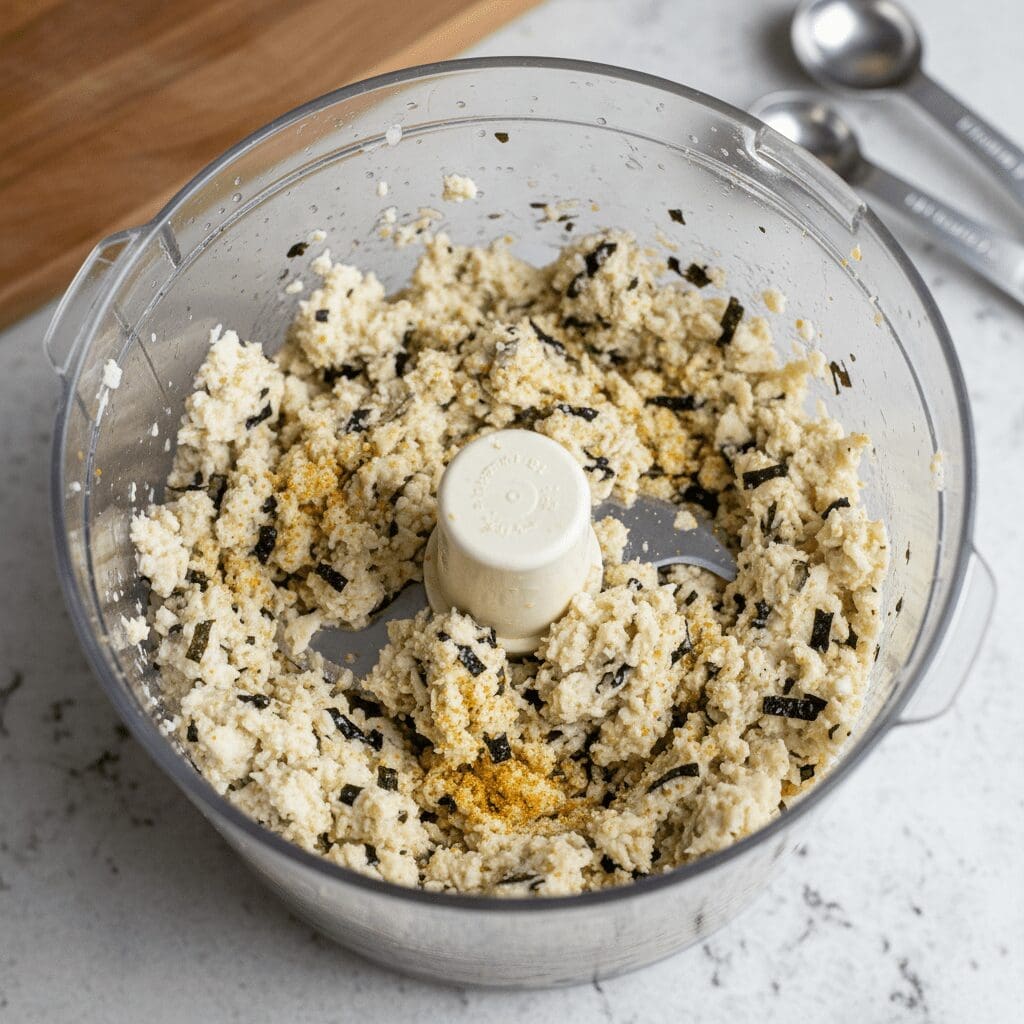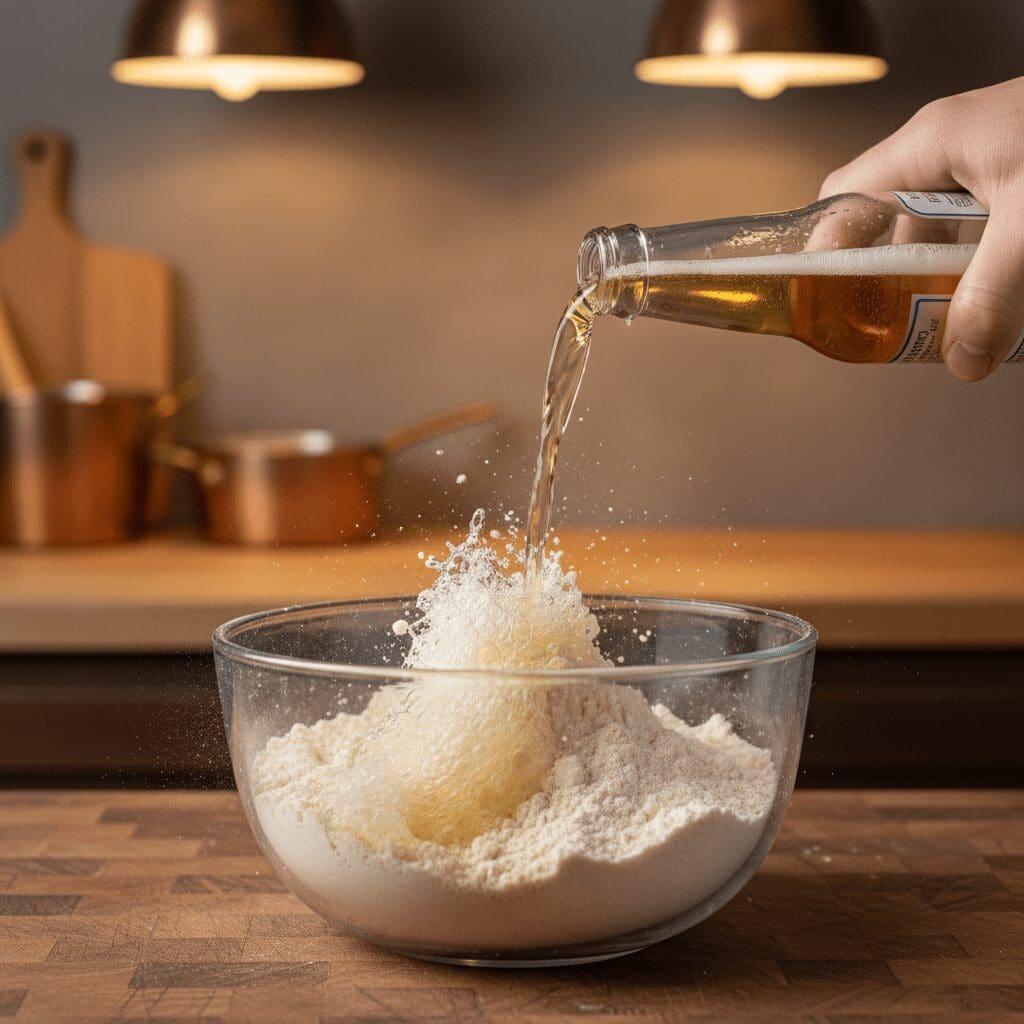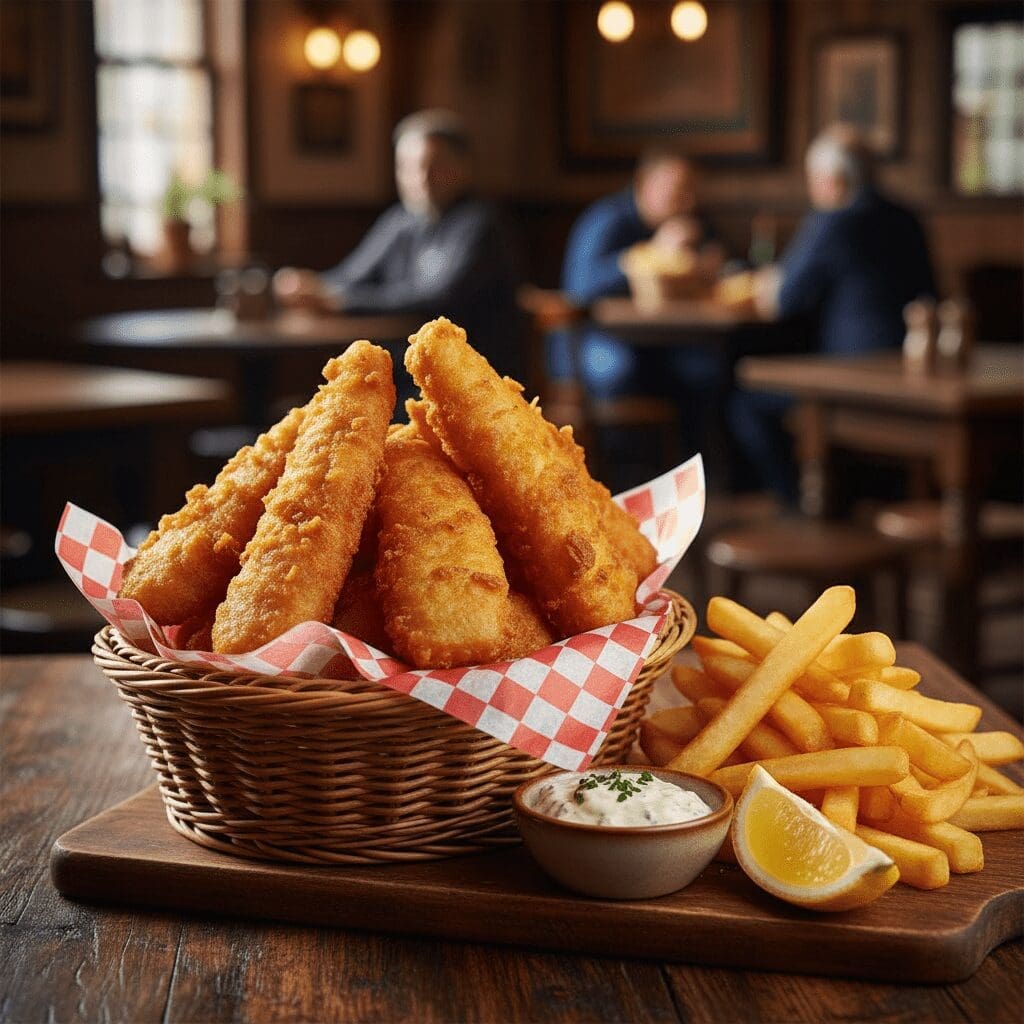The Crispiest Beer Battered Vegan Fish (That’s Better Than the Real Thing)

Remember the satisfaction of a perfect plate of fish and chips? That shatteringly crisp, golden batter giving way to a tender, flaky interior.
Now, what if you could capture that exact experience, but make it entirely plant-based? That’s exactly what this recipe delivers.
We’re not just giving you a list of ingredients; we’re walking you through the techniques and the science to create the most incredible Beer Battered Vegan Fish you’ve ever tasted. Using the surprising magic of hearts of palm and a perfectly formulated beer batter, this recipe creates a vegan fish and chips experience that rivals the original.
Get ready to master a new plant-based classic.
- Why This Recipe Delivers a Perfect Crunch Every Time
- Gathering Your Tools and Ingredients
- What’s the Secret to the Perfect Vegan ‘Fish’ Fillet?
- What Kind of Beer Is Best for the Batter?
- How to Make Beer Battered Vegan Fish Step-by-Step
- Common Questions and Troubleshooting
- How Should I Serve My Vegan Fish?
- Storing and Reheating for a Second Crispy Meal
- Conclusion
Why This Recipe Delivers a Perfect Crunch Every Time

The magic of this recipe lies in the science of the batter and the clever use of ingredients. It’s not just about mixing things together; it’s about understanding why it works so well.
The Power of a Cold Beer Batter
The quintessential crispiness of a great beer batter comes down to three factors:
- Carbonation: The bubbles in beer create tiny pockets of air in the batter. When this hits the hot oil, these pockets expand rapidly, resulting in a light, airy, and incredibly crispy crust that’s far superior to batters made with plain water.
- Temperature: As food scientist Harold McGee explains, a cold batter slows down gluten formation. Less gluten means a more tender, delicate crust, not a tough, chewy one. Keeping your beer ice-cold is a non-negotiable step for maximum crispiness.
- Alcohol: Alcohol evaporates faster than water. This rapid evaporation helps the batter dry out quickly in the fryer, contributing to a crispier finish.
Hearts of Palm: The Perfect Fish Stand-In
We’re skipping the tofu and chickpeas. Hearts of palm are the star here because their natural texture is soft, layered, and slightly flaky, mimicking cooked whitefish beautifully. When pulsed briefly in a food processor, they break down into tender chunks that hold together perfectly. Complemented by the oceanic umami of nori and the classic seafood taste of Old Bay, they create a ‘fish’ fillet that is both texturally and flavorfully convincing.
Gathering Your Tools and Ingredients

Having the right tools and all your ingredients ready (a practice known as mise en place) is the first step to a stress-free frying experience. It ensures you can work efficiently and safely once the oil is hot.
Required Kitchen Equipment
- Food Processor: Essential for breaking down the hearts of palm to the right consistency.
- Large, Heavy-Bottomed Pot or Dutch Oven: Provides stable heat for deep frying.
- Deep-Fry Thermometer: This is the most critical tool for safety and success. Guessing the oil temperature leads to greasy or burnt results.
- Wire Rack: For draining the fried ‘fish’. This allows air to circulate, keeping the bottom crispy.
- Spider Strainer or Slotted Spoon: For safely adding and removing items from the hot oil.
- Mixing Bowls & Whisk
Key Ingredients
- For the ‘Fish’: Canned Hearts of Palm, Panko Breadcrumbs, Vegan Mayo, Nori Sheets, Old Bay Seasoning, Salt.
- For the Batter: All-Purpose Flour, Garlic Powder, Paprika, Old Bay, Salt, Pepper, and a cold Beer.
- For Frying: A neutral oil with a high smoke point, like canola, vegetable, or peanut oil.
What’s the Secret to the Perfect Vegan ‘Fish’ Fillet?

The heart of this recipe is the clever combination that transforms a simple vegetable into a convincing seafood alternative. It’s all about layering flavors and textures.
- Hearts of Palm: This is your flaky ‘fish’ base. When you process it, be sure to use the ‘pulse’ function. You want to break it down but leave plenty of texture and even some larger chunks. Over-processing will turn it into a paste, so aim for a coarse, crab-cake-like consistency.
- Nori (Dried Seaweed): This is your secret weapon for an authentic ‘taste of the sea’. Crumbled nori sheets distribute a subtle, savory, and oceanic flavor throughout the mixture. You can find nori in the international aisle of most supermarkets.
- Old Bay Seasoning: This classic blend of herbs and spices is synonymous with seafood boils and fish fries. Its iconic flavor profile, featuring celery salt, paprika, and other spices, instantly makes the dish taste familiar and authentic.
What Kind of Beer Is Best for the Batter?

The type of beer you choose significantly impacts the batter’s final taste and appearance. The goal is maximum crispiness with a neutral flavor.
The Best Beers to Use
- Lagers and Pilsners: These are your top choices. They are light in color and flavor, and highly carbonated. This means they won’t darken the batter too much or impart a heavy, malty taste.
- Pale Ales: A light pale ale can also work well if you prefer a slightly more complex flavor, but stick to the paler varieties.
Beers to Avoid
- Stouts, Porters, and Dark Beers: These will make the batter dark, heavy, and can introduce bitter or roasted flavors that overpower the delicate ‘fish’.
- Strongly Flavored IPAs: The intense hoppiness of many IPAs can make the batter bitter, a common issue noted in the original recipe’s comments.
Is Your Beer Vegan?
Many beers are fined using animal products like isinglass or gelatin. To be sure your choice is vegan-friendly, you can check the comprehensive database on Barnivore.
How to Make Beer Battered Vegan Fish Step-by-Step

Follow these steps methodically for perfect results. The key is to work gently with the ‘fish’ patties before they are fried—they become much sturdier once cooked.
- Prepare the ‘Fish’ Mixture: In a food processor, add the drained hearts of palm, panko, vegan mayo, crumbled nori, Old Bay, and salt. Pulse 5-7 times until combined but still chunky. Don’t turn it into a paste! If the mixture seems overly wet, add more panko, a tablespoon at a time.
- Shape and Chill the Fillets: Using your hands, take about 2 tablespoons of the mixture and form it into small, fillet-like shapes. Place them on a parchment-lined baking sheet. This step is crucial: Refrigerate the fillets for at least 30 minutes. Chilling helps them firm up and hold their shape when battered.
- Mix the Batter: While the fillets are chilling, whisk together the flour, garlic powder, paprika, Old Bay, salt, and pepper in a large bowl. Slowly pour in the very cold beer, whisking until the batter is smooth. It should have the consistency of thick pancake batter.
- Heat the Oil: Pour 2-3 inches of oil into your heavy-bottomed pot. Attach your thermometer to the side and heat the oil over medium-high heat until it reaches exactly 375°F (190°C).
- Batter and Fry: Working one at a time, gently dip a chilled fillet into the batter, coating it completely. A fork is great for this. Let any excess batter drip off, then carefully lower it into the hot oil. Fry 2-3 fillets at a time to avoid overcrowding the pot, which lowers the oil temperature.
- Cook to Golden Brown: Fry for about 3 minutes per side, until the batter is a deep golden brown and beautifully crisp.
- Drain and Serve: Use a spider strainer to remove the fillets from the oil and place them on a wire rack to drain. Serve immediately while hot and crispy.
Common Questions and Troubleshooting

Even with a great recipe, small issues can arise. Here’s how to troubleshoot the most common problems to ensure your vegan fish is flawless.
“Why is my batter not crispy?”
This is almost always an oil temperature issue. If the oil is too cool (below 360°F), the batter absorbs oil instead of instantly crisping, leading to a greasy, soggy result. If it’s too hot (above 400°F), the batter will burn before the inside is warmed through. Use a thermometer and maintain that 375°F sweet spot.
“Why did my ‘fish’ fillets fall apart?”
This can happen for two reasons. First, the ‘fish’ mixture was too wet. Add a bit more panko to bind it. Second, and more commonly, you didn’t chill the patties long enough. The 30-minute chilling step is essential for helping them firm up and survive the battering and frying process. Handle them very gently before they hit the oil.
“My batter tasted bitter. What went wrong?”
You likely used the wrong kind of beer. A dark beer (stout, porter) or a very hoppy IPA will impart a bitter flavor. Stick to a neutral, light-colored lager or pilsner for the best results.
“Can I make these gluten-free?”
Yes. For the ‘fish’ mixture, use gluten-free panko or breadcrumbs. For the batter, swap the all-purpose flour for a good quality gluten-free 1-to-1 baking blend and use your favorite gluten-free beer or unflavored sparkling water.
“Can I bake or air fry them instead?”
While I haven’t tested it for this specific recipe, deep frying is highly recommended for that authentic, rich, and crispy texture. Baking or air frying will produce a much different, less crunchy result. If you do try it, spray the battered fillets generously with oil and air fry at around 400°F for 15-20 minutes, flipping halfway through.
How Should I Serve My Vegan Fish?

You’ve made the perfect golden fillets, now it’s time to build the ultimate meal. While classic french fries are a must, here are a few other ways to serve your vegan fish.
- Classic Fish and Chips: Serve hot and fresh with thick-cut french fries, a generous dollop of Vegan Tartar Sauce, and bright lemon wedges for squeezing over the top. A side of mushy peas or coleslaw completes the pub experience.
- Crispy Fish Tacos: Slice the fillets into strips and serve them in warm corn tortillas. Top with a creamy chipotle slaw, pickled red onions, fresh cilantro, and a slice of avocado for a fantastic texture and flavor combination.
- The Ultimate Fish Sandwich: Place a whole fillet on a toasted brioche bun with lettuce, tomato, and plenty of tartar sauce. This makes for an incredibly satisfying and hearty lunch.
- As a Main Protein: Serve the fillets alongside a fresh green salad with a lemon vinaigrette or with a side of roasted asparagus and quinoa for a lighter, more balanced meal.
Storing and Reheating for a Second Crispy Meal

While these are undeniably best eaten fresh from the fryer, you can store and reheat leftovers effectively to bring back some of that original crunch.
- Storing: Allow the fillets to cool completely. Store them in an airtight container in the refrigerator for up to 2 days.
- Reheating for Maximum Crispiness: The air fryer is your best friend here. Place the fillets in the air fryer basket in a single layer and heat at 350°F (175°C) for 5-8 minutes, or until heated through and crispy again. The oven also works well; place them on a baking sheet in a preheated 375°F (190°C) oven for about 10-15 minutes. Avoid the microwave at all costs, as it will make the batter soft and soggy.
- Can They Be Frozen? I haven’t personally tested freezing the fried fillets, as the texture of fried food can change upon thawing. However, you could likely freeze the un-fried, shaped patties. Place them on a baking sheet to freeze individually, then transfer to a freezer-safe bag. You can then batter and fry them directly from frozen, adding a few extra minutes to the cooking time.
Conclusion
You now have all the secrets to creating a truly unforgettable vegan fish and chips experience right in your own kitchen. This recipe is more than just a meal; it’s a celebration of how creative and delicious plant-based cooking can be.
By understanding the science behind the perfect batter and the unique texture of hearts of palm, you can achieve that perfect, crispy, and flavorful result every single time. So, gather your ingredients, fire up the fryer, and get ready to impress yourself and anyone lucky enough to share your table.
